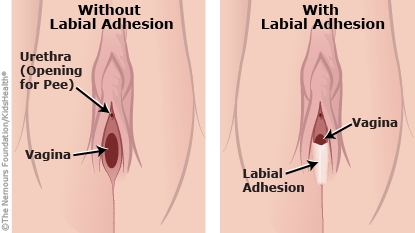Labial adhesions happen when the labia minora (the inner folds of skin surrounding the vaginal opening) become fused together. Most often they're found at a baby's or young child's routine health visit by their health care provider.
Labial adhesions will go away on their own during puberty if not well before that, so they only need treatment if a large part of the labia is fused or the adhesions cause symptoms (such as trouble peeing or infections). If treatment is needed, health care providers prescribe an estrogen or steroid cream to help the adhesions come apart. Very rarely, a simple surgery is needed to separate the adhesions.





What causes labial adhesions? The exact cause of labial adhesions isn't clear. In babies and females who haven't gone through puberty, the labia are very delicate and easily irritated. The adhesions may form as the body heals from irritation.
Because adhesions are less common after females go through puberty and estrogen levels rise, low estrogen levels likely play a role.
Do labial adhesions cause any long-term problems? No, they don't cause any lasting problems and later in life won't affect sexuality or fertility (ability to have children).